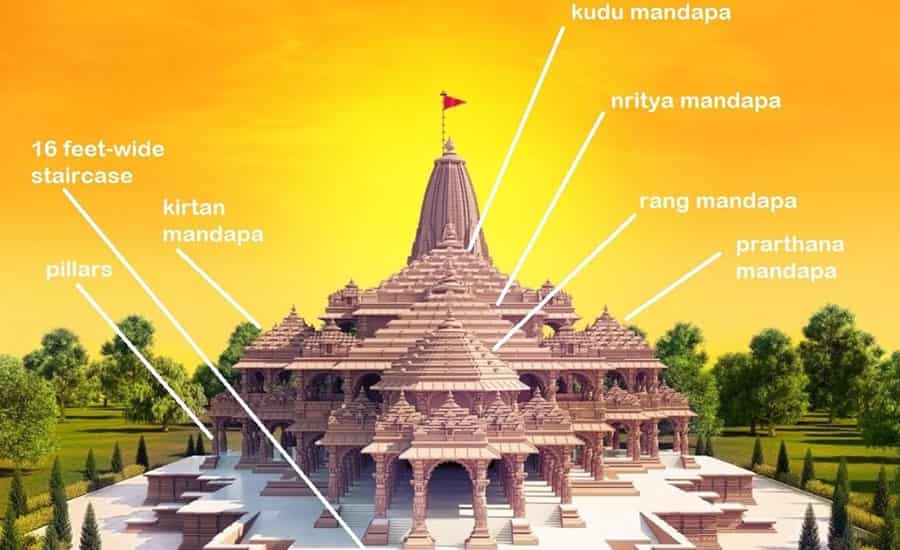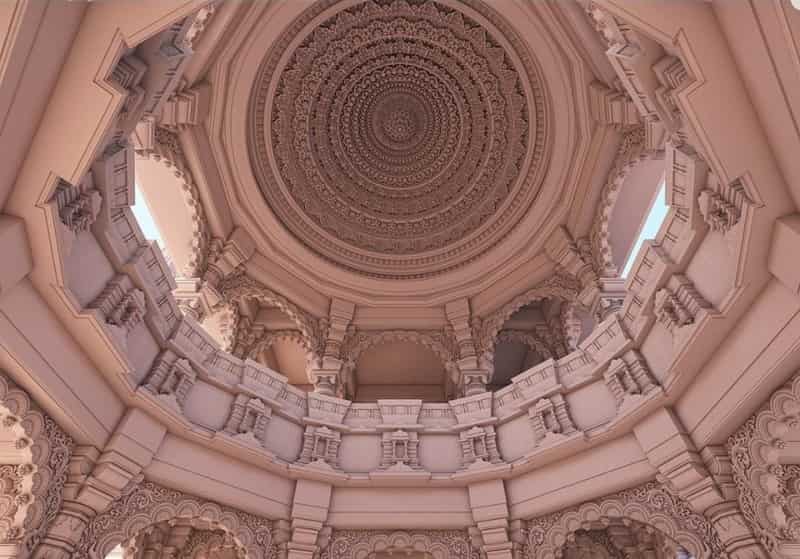The Ram Mandir in Ayodhya is an architectural marvel that blends historical legacy and meticulous design evolution. Originating in 1988 under the visionary Sompura family, renowned architects, the temple’s design evolved in 2020, rooted in Hindu texts. Planned to be the world’s third-largest Hindu shrine, its dimensions are 235 feet wide, 360 feet long, and 161 feet high. Architectural highlights include Nagara-style mandapas and 366 columns representing deities. Overseen by Larsen & Toubro, the complex extends beyond the main shrine, offering a holistic experience for over 70,000 visitors. In essence, the Ram Mandir stands as a cultural and spiritual marvel, embodying India’s rich heritage.

Historical Genesis and Design Origins (1988)
The original design for the Ram temple was conceived in 1988 by the Sompura family, renowned architects from Ahmedabad, with a rich legacy spanning 15 generations. Notable for their contributions to over 100 temples globally, including the iconic Somnath temple, the chief architect was Chandrakant Sompura, supported by his architect sons Nikhil and Ashish.
Evolution of Design (2020)
In 2020, a revised design, aligned with Hindu texts such as vastu shastra and the Shilpa Shastras, was prepared by the Sompuras. This updated blueprint introduced alterations while maintaining the traditional essence of the temple. The design was unveiled during the Prayag Kumbh Mela in 2019.
Structural Dimensions and Grandeur
The temple is planned to be 235 feet wide, 360 feet long, and 161 feet high, positioning it as the world’s third-largest Hindu shrine upon completion. Embracing the Gujara-Chaulukya style of Northern Indian temple architecture, the grandiosity of the design was showcased in a model during the Prayag Kumbh Mela.
Architectural Features
Elevated on a raised platform, the main structure will have three storeys, featuring five mandapas in the garbhagriha and at the entryway. Adhering to the Nagara style, these mandapas will be adorned with shikhara. A total of 366 columns, each adorned with 16 idols representing various deities, will grace the structure.
Temple Complex and Facilities
Covering 10 acres, the temple complex extends beyond the main shrine. This includes a prayer hall, lecture hall, educational facilities, a museum, and a cafeteria, with a total of 57 developed acres. The temple committee anticipates that over 70,000 visitors will be accommodated.
Construction Oversight and Collaborations
Larsen & Toubro, offering its services free of cost, has been entrusted with overseeing the design and construction of the temple. Collaboration with esteemed institutions such as the Central Building Research Institute and Indian Institutes of Technology for soil testing, concrete, and design highlights the meticulous planning.
Materials and Construction Techniques
The construction involves 600 thousand cubic feet of sandstone from the Bansi pahadpur village mountain in Rajasthan. A distinctive aspect is the exclusion of iron in construction, with ten thousand copper plates facilitating the fusion of stone blocks.
International Symbolism
Thailand symbolically contributes to the temple’s inauguration by sending soil to the Ram Janmabhoomi, building on their earlier gesture of sending water from two rivers in Thailand to honor the temple.
Presiding Deity – Ram Lalla Virajman
Ram Lalla Virajman, the infant form of Rama and an avatar of Vishnu, serves as the presiding deity of the temple. Ram Lalla was a litigant in the 1989 court case, recognized as a “juristic person” and represented by Triloki Nath Pandey, a senior VHP leader.
Temple Trust Vision and Final Blueprint
According to the temple trust, the final blueprint includes dedicated temples to Surya, Ganesha, Shiva, Durga, Vishnu, and Brahma within the temple grounds. Two idols of Ram Lalla, one being 5 years old, will find their place in the sanctum.
Nagara Style of Temple Architecture
Exploring the Nagara style, predominant in northern India, the architecture involves an upraised platform (jagati), mandapas adorned with shikhara, and a distinctive spire. Notable is the absence of elaborate boundary walls and gateways, distinguishing it from south Indian temples.
Shikhara Varieties and Comparisons

The temple’s shikhara exhibits the phamsana-style, with a square base and rectilinear outline. A comparison with the Khajuraho Vishwanath temple reveals similarities in the latina-style shikhara, characterized by a curved pyramidal fashion culminating in an Amalaka topped with a Kalasha.
Chief Architect and Timeline
Chandrakant bhai Sompura, the chief architect, with a notable lineage including the design of the Akshardham temple in Gujarat, estimates a completion time of approximately three and a half years. The foundation will incorporate over two lakh bricks inscribed with ‘Sri Rama’ collected from across the country.
In essence, the architecture of the Ram Mandir in Ayodhya blends historical legacy, meticulous design evolution, grand structural dimensions, and cultural symbolism, making it a significant testament to India’s rich architectural and religious heritage.
- Suggested Tour: Ayodhya Holiday Packages

 Call
Call WhatsApp
WhatsApp Enquiry
Enquiry